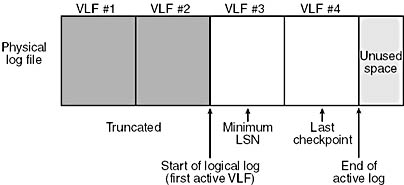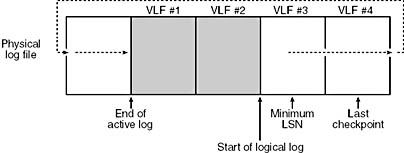Changes in Log Size
No matter how many physical files have been defined for the transaction log, SQL Server always treats the log as one contiguous file. For example, when the DBCC SHRINKDATABASE command determines how much the log can be shrunk, it does not consider the log files separately but determines the shrinkable size based on the entire file.
The transaction log for any database is managed as a set of Virtual Log Files (VLFs) whose size is determined internally by SQL Server, based on the total size of all the log files and the growth increment used when enlarging the log. A log always grows in units of entire VLFs and can only be shrunk to a VLF boundary. (Figure 5-2 on the following page illustrates a physical log file along with several VLFs.) A VLF can exist in one of the following three states:
- Active The active portion of the log begins at the minimum log sequence number (LSN) representing an active (uncommitted) transaction. The active portion of the log ends at the last LSN written. Any VLFs that contain any part of the active log are considered active VLFs. (Unused space in the physical log is not part of any VLF.)
- Recoverable The portion of the log preceding the oldest active transaction is only needed to maintain a sequence of log backups for recovery purposes.
- Reusable If transaction log backups are not being maintained , or if you have already backed up the log, VLFs prior to the oldest active transaction are not needed and can be reused.

Figure 5-2. The multiple virtual log files that make up a physical log file.
SQL Server will assume you're not maintaining a sequence of log backups if any of the following are true:
- You have truncated the log using BACKUP LOG WITH NO_LOG or BACKUP LOG WITH TRUNCATE_ONLY.
- You have set the database to truncate the log automatically on a regular basis with the database option trunc. log on chkpt .
- You have performed an unlogged operation (like fast BCP) since the last full database backup.
- You have never taken a full database backup.
In any of the situations just described, when SQL Server reaches the end of the physical log file, it will start reusing that space in the physical file by circling back to the file's beginning. In effect, SQL Server will recycle the space in the log file that is no longer needed for recovery or backup purposes. If a log backup sequence is being maintained, the part of the log before the minimum LSN cannot be overwritten until those log records have actually been backed up. Once you have performed the log backup, SQL Server can circle back to the beginning of the file. Once SQL Server has circled back to start writing log records earlier in the log file, the reusable portion of the log is then between the end of the logical log and active portion of the log. Figure 5-3 on the following page depicts this cycle.

Figure 5-3. The active portion of the log circling back to the beginning of the physical log file.
You can actually observe this behavior in one of the sample databases, such as pubs , assuming you have never made a full backup of the database. If you have never made any modifications to pubs , the size of its transaction log file will be just about 0.75 MB. This next script creates a new table in the pubs database, inserts three records, and then updates those records 1000 times. Each update is an individual transaction, and each one is written to the transaction log. However, you should note that the log has not grown at all, even after 3000 update records are written. (If you have already taken a backup of pubs , you might want to re-create the database before trying this example. You can do that by running the script instpubs.sql in the folder \mssql7\install.)
CREATE TABLE newtable ( a int) GO INSERT INTO newtable VALUES (10) INSERT INTO newtable VALUES (20) INSERT INTO newtable VALUES (30) GO DECLARE @counter int SET @counter = 1 WHILE @counter < 1000 BEGIN UPDATE newtable SET a = a + 1 SET @counter = @counter + 1 END |
Now make a backup of the pubs database after making sure that the option trunc. log on chkpt. is not set. (We'll look at database options later in this chapter.) You can use this statement to make the backup, substituting for c: whatever drive your SQL Server is installed on:
BACKUP DATABASE pubs to disk = 'c:\mssql7\backup\pubs.bak' |
Run the update script again, starting with the DECLARE statement. You should see that the physical log file has now grown to accommodate the log records added. The initial space in the log could not be reused because SQL Server assumed that you were saving that information for backups.
Now you can try to shrink the log back down again. If you issue the following command:
DBCC SHRINKDATABASE (pubs) |
Or if you issue the DBCC SHRINKFILE command for the log file, SQL Server will mark a shrinkpoint in the log, but no actual shrinking will take place until log records are freed by either backing up or truncating the log. You can truncate the log with this statement:
BACKUP LOG pubs WITH TRUNCATE_ONLY |
At this point, you should notice the physical size of the log file has been reduced. If a log is truncated without any prior shrink command issued, SQL Server will mark the space used by the truncated records as available for reuse, but it does not change the size of the physical file.
In certain circumstances, you might notice that running the above commands exactly as specified still does not shrink the physical log file. This can happen when the active part of the log is located at the end of the physical file. Physical shrinking can only take place from the end of the log, and the active portion is never shrinkable. To remedy this situation, you can carry out the following four steps:
- Make sure earlier VLFs are reusable by backing up or truncating the log.
- Execute a few dozen update statements so that the active VLF moves to an earlier physical location.
- Execute DBCC SHRINKDATABASE to mark a shrinkpoint.
- Truncate or backup the log a second time to force the physical shrinkage .
NOTE
If a database log backup sequence is not being maintained for a database, the database can be set into log truncate mode by setting the trunc. log on chkpt . database option to TRUE. In conjunction with the autoshrink option, this means that the log will be physically shrunk at regular intervals. Contrary to the SQL Server 7 documentation, a database does not come out of log truncate mode by backing up the full database.
If a database has the autoshrink option on, an autoshrink process kicks in once every 30 minutes and determines the size to which the log should be shrunk. The log manager accumulates statistics on the maximum amount of log space used in the 30-minute interval between shrinks. The autoshrink process marks the shrinkpoint of the log as 125 percent of the maximum log space used or as the minimum size of the log, whichever is larger. (Minimum size is the creation size of the log or the size to which it has been manually increased or decreased.) The log will then shrink to that size whenever it gets the chance, which will be when either the log gets truncated or backed up. It's possible to have autoshrink without having trunc. log on chkpt. , although there's no way to guarantee that the log will actually shrink. (If, for example, the log is never backed up, it will never be cleared.)
EAN: 2147483647
Pages: 144